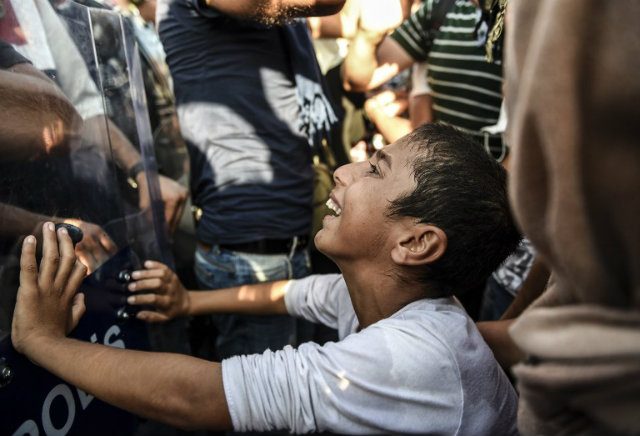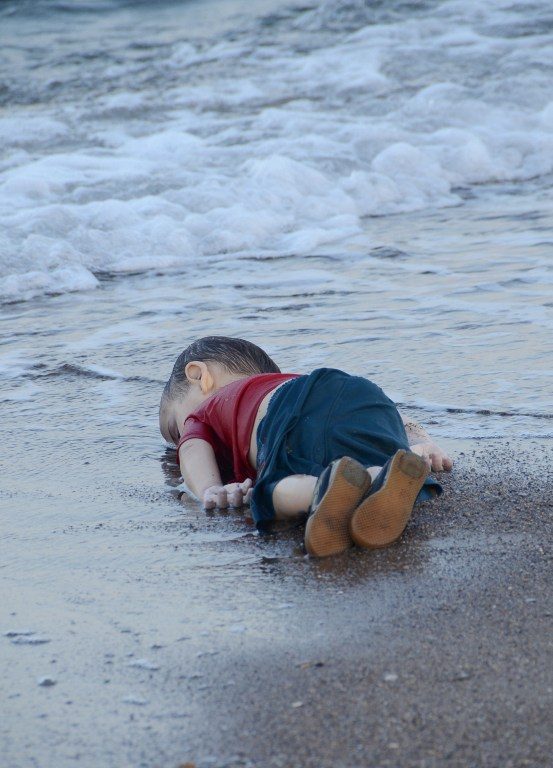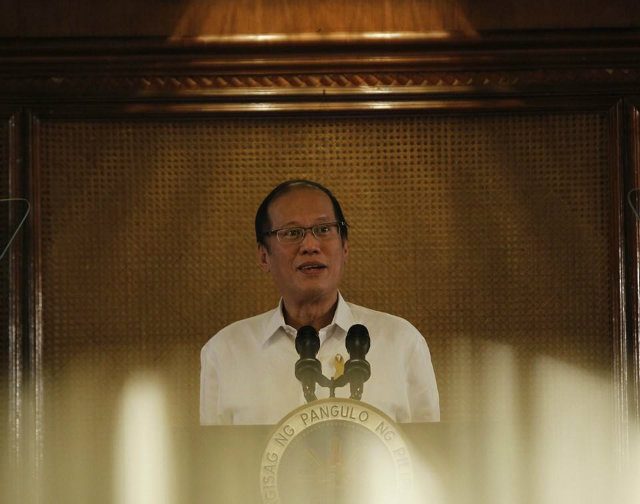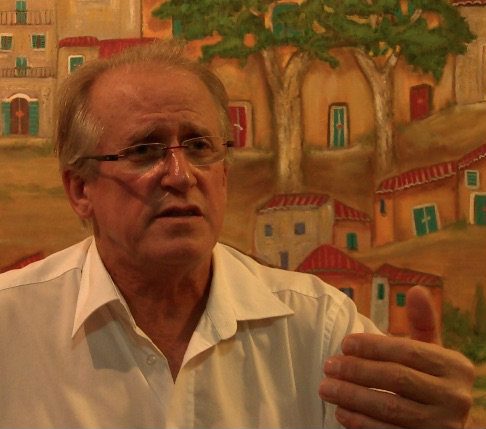SUMMARY
This is AI generated summarization, which may have errors. For context, always refer to the full article.

MANILA, Philippines (UPDATED) – “Does the daang matuwid (straight path) stop within the borders of the Philippines?”
The head of the United Nation’s refugee agency in the Philippines posed this question to President Benigno Aquino III as he issued his strongest call yet for the Philippines to accept Syrian refugees.
Bernard Kerblat, United Nations High Commissioner for Refugees (UNHCR) representative to the Philippines, urged Aquino to respond to his agency’s invitation for Manila to admit Syrian refugees faced with the bleak choice of enduring bombardment in their war-torn country or risking drowning to escape an uncertain future in Europe. (READ: The Philippines and the crisis in Europe)
“We would like to renew this call to explore the possibility for the government of the Philippines to take a proactive role in selecting refugees,” Kerblat told Rappler. “What is say, 150 refugees in the overall scheme when we talk about millions on the move, millions in refugee camps, millions without a future?”
In an interview, the UN official disclosed that his agency has been in talks with the Philippine government for 24 months now on the possibility of accepting refugees from Syria. Yet the latest wave of migration that sparked Europe’s biggest refugee crisis since the Second World War made the invitation all the more urgent.
To date, Kerblat said the UNHCR has yet to receive a response. Aquino publicly said the Philippines will welcome the refugees if they arrive in its shores but does not want to “take on more than what we can handle.”
Kerblat lauded the stance but believes that the Southeast Asian nation with a long history of hosting refugees has the financial, legal, and moral means to extend its trademark hospitality.
“The Philippines is much better off today economically speaking, in terms of governance, in terms of stability of its institutions. What we are seeing now is the fruits of a line taken by this administration, the daang matuwid. Can it be extended also in offering solutions to people who are victims of persecution outside of this country? We are simply asking the question.”

‘What is the reluctance?’
There are 4 million Syrian refugees, a human river fleeing to neighboring countries and Europe in search of a better life. At times facing hostility and xenophobia, their plight and the global response to it were captured in the widely-circulated photo of drowned Syrian toddler Aylan Kurdi, and a video from a Hungarian camp showing families “fed like animals in a pen.”
This week, the crisis escalated with Hungary closing its borders, and using tear gas and water cannon on refugees, a move the UN condemned. European leaders are meeting in an emergency summit on September 23, a unified solution still elusive.
Five thousand miles away, some of the refugees ended up in the Philippines, a country of 100 million. Since the Syrian civil war began in 2011, Kerblat said 67 Syrians sought asylum here, with 31 of them already given refugee status. He praised the Philippines’ “impeccable track record” in handling asylum-seekers.
Yet the UNHCR is asking the Philippines to participate in a broader “international effort of solidarity” beyond receiving asylum-seekers who head to the country on their own.
“What we are proposing is, will the Philippines be prepared to look at options, and sit down with already 64 [UN] member-states who have joined in offering either temporary protection or admission or granting refugee status to people in need of asylum,” said Kerblat.
One option is for the Philippines to invoke its forward-thinking asylum legislation. The Immigration Act of 1940 authorizes the President to admit refugees for humanitarian reasons “under such conditions as he may prescribe.” The law was in place 11 years before the world crafted the 1951 Refugee Convention, the key legal text defining refugees’ rights. (READ: TIMELINE: Philippine laws and policies on refugees)
Kerblat said Aquino can issue a special type of humanitarian visa to a “symbolic number” of refugees, and ask the UNHCR to screen them. The Philippines can even specify their background to protect the most needy, or to get those who can contribute to its economy.
“Some countries are saying in a very humanitarian way, ‘Out of this admission quota, I would like to accept 25 victims of torture or women-headed households because they are more vulnerable.’ Or say, ‘We need skilled masons or electricians.’”
He added: “We can marry all these criteria but the starting point of the discussion is a political willingness to say, ‘Yes, I would like to contribute by admitting refugees into my country.’”
Besides legal grounds, the Philippines has a tradition of being a haven to 9 waves of refugees.
They include Jewish refugees who President Manuel Quezon saved from death during the Holocaust. President Elpidio Quirino also welcomed the so-called White Russians fleeing communism in Russia and China in 1949.
Kerblat said, “Therefore, the question comes to my mind: what is the reluctance to contemplate a repeat of what your ancestors have done?”

‘International aid will come in’
Aquino did identify the source of his reluctance in an interview with the Philippine Daily Inquirer on September 8. “[A] vast majority of our people are still living in poverty. We’d like to take our resources to better our people and do our fair share, and that is a question perhaps: what is fair?”
Philippine foreign affairs spokesman Charles Jose echoed Aquino, saying that while the Philippines will abide by its international commitments, it should also consider its own resources and capabilities.
Jose pointed out that the country is still focused on rehabilitation from Super Typhoon Yolanda (Haiyan), the world’s most powerful storm to hit land, which ravaged the Visayas in November 2013, and killed over 6,000.
“The Philippines will continue to support international efforts to address the refugee problem through regional cooperation and the UN framework,” the assistant secretary told Rappler.
Palace Communications Secretary Herminio Coloma Jr held the same position when asked about the remarks of Kerblat.
“We need to assess our resource capabilities as we do have real resource constraints,” he told Rappler on Saturday, September 19.
Pressed about taking in even just the symbolic number of 150 to 500 refugees, Coloma said: “My statement suffices.”
‘We will spare no effort to ensure this is a success, not just for the refugees but also for the receiving community and the receiving country.’
– UNHCR’s Bernard Kerblat, urging the Philippines to admit Syrian refugees
Like other countries considering accepting refugees, the Philippines is grappling with internal problems like Yolanda and the Zamboanga siege of 2013. It also has its own internally displaced persons due to armed conflict in parts of Mindanao, the indigenous people called Lumad being the latest victims.
The UNHCR said that domestic concerns are valid but the international community will come to the aid of the Philippines if it makes the bold decision, like it did in the wake of Yolanda.
“We will spare no effort to ensure this is a success, not just for the refugees but also for the receiving community and country. I can almost guarantee that international assistance will come in to support these people,” said Kerblat, a humanitarian worker of 33 years.
To put things in perspective, Lebanon hosts 1.2 million Syrian refugees, one in 5 people in the country. The Greek island of Lesbos has 20,000 refugees for a population of 80,000.
Even Latin American countries like Uruguay, Argentina, and Chile offered to take in Syrian refugees.
Kerblat compared the situation to a barangay (village) captain looking for people who can shelter residents after a fire.
“It’s the same thing in the concert of nations, when the High Commissioner for Refugees turns to member-states who have the means, willingness to admit people. We need to have physical space. The UN does not have a territory. Its moral force rests on its member-states.”
‘Exemplary, heroic decision’
There are many things Filipinos can do to help. Taking the cue from Pope Francis, Catholic bishops urged those abroad to welcome refugees, while Filipinos here can donate cash to the underfunded global response.
Kerblat said NGOs expert in health, water, sanitation and education can reach out, while local government units can sponsor refugees. Symbolic contributions from the Philippines like rice can also be consigned through the World Food Programme.
“This is not a Middle Eastern affair. This is not a European affair. This is a global issue to which each of us has a responsibility and can make a difference for the people,” he said.
Yet the UNHCR representative argued that the most pressing need remains admitting refugees. While a symbolic figure like 150 or 500 will not make a dent, given the magnitude of the crisis, the Philippines taking action will have a far-reaching moral effect.
“That decision will have an incredible example-setting practice. Here is the Philippines, barely recovering from Yolanda, confronted with multiple domestic serious issues, and yet extending solidarity,” he said.
“That will be looked at by the rest of the international community as an exemplary, heroic decision.” – Rappler.com
Add a comment
How does this make you feel?

There are no comments yet. Add your comment to start the conversation.